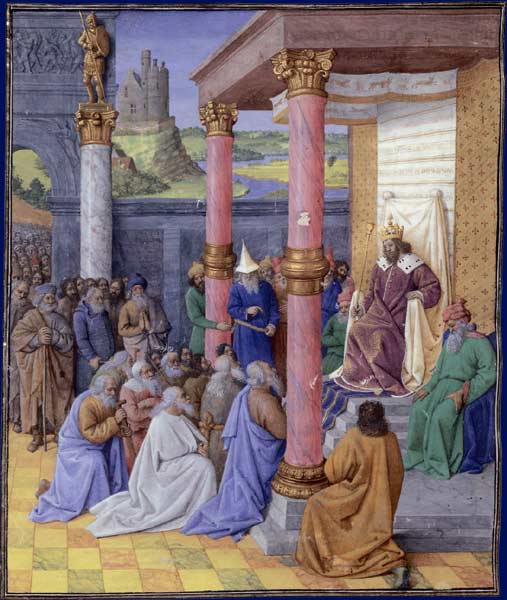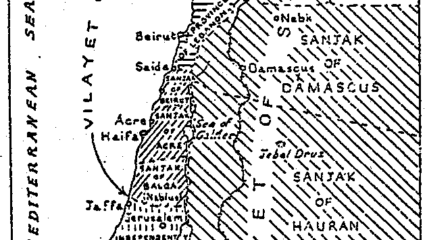Iran’s relations with Israel and the Jewish people from ancient times to the present day.
June 23-June 24, 2025 — At the request of President Donald Trump, Iran and Israel enter a cease-fire to end their Twelve-Day War, although no formal agreement is released. No details are announced about how, when and with what parameters the cease-fire could evolve into direct or indirect negotiations.
June 21, 2025 — After offering Iranian leaders options to negotiate ceasing their nuclear development program and being turned down, President Donald Trump deploys U.S. B-2 Spirit bombers carrying 30,000-pound deep-penetration munitions, as well as submarine-launched cruise missiles, to destroy three key locations in Iran’s nuclear weapons program.
June 11, 2025 — Israel pre-emptively attacks Iran to destroy, degrade or remove its nuclear enrichment program and the nuclear weaponization program, kill leading nuclear scientists and the regime’s military elite engaged in operations against Israel, neutralize the uranium enrichment facility in Natanz, and damage Iran’s ballistic missile infrastructure. Israel does not target Iran’s population. Iran retaliates with ballistic missile and drone attacks against Israeli cities.
May 29, 2025 — Syria and Israel are reportedly in “deconflict” talks prompted by Saudi Arabia and the United States seeking a reduction in Syrian-Israeli tension, thus further undermining the anti-Israel Syrian-Iranian alliance.
May 28, 2025 — Israel attacks the Houthi-controlled airport in Sanaa, Yemen, in retaliation for Houthi drone and ballistic missile attacks against Israel in April and May.
May 28, 2025 — The Iranian supreme leader’s international affairs adviser, Ali Akbar Velayati, meets with the Palestinian Islamic Jihad representative to Iran, Nasser Abu Sharif, and the Hamas representative to Iran, Khaled Qaddoumi, in Tehran. Velayati reiterates Iran’s long-standing objective to destroy the State of Israel through proxy groups and praises the Houthis for their continued attacks on Israel. Sharif said May 14 that Iran has continued to fund PIJ.
May 26, 2025 — Israel is reported to be prepared to attack Iran’s nuclear facilities, while President Donald Trump announces that the United States and Iran are close to a deal to end Iran’s nuclear weapons development in exchange for $6 billion in Iranian funds held by the United States in reaction to the Hamas attack on Israel on October 7, 2023.
May 14, 2025 — New Syrian leader Ahmed al-Sharaa meets with President Trump, pushing al-Sharaa into consideration, if not a mild embrace, of allying with the United States and Saudi Arabia and helping Israel to eliminate Iranian connections to Syria.
February 4, 2025 — President Trump signs a national security presidential memorandum that directs U.S. officials to impose “maximum pressure” on Iran to compel it to abandon its nuclear program and its support for terrorist groups. It also directs the imposition and enforcement of sanctions, issuance of guidance to industry, pursuit of Iran’s diplomatic isolation, and legal steps against Iranian activities inside the United States.
December 6, 2024 — Syrian President Bashar al-Assad falls from power and flees to Russia, crippling Iran’s overland supply of arms to its paid fighters in Syria and to its Hezbollah client in Lebanon. New Syrian leader Ahmed al-Sharaa, with Saudi support, seeks to wind down Syrian antagonism toward Israel, sustained by all Syrian regimes since Israel’s establishment in 1948.
October 26, 2024 — In reprisal for Iran’s October 1 ballistic missile attack, Israel strikes dozens of sites across Iran, targeting air defense batteries, military plants, and the Revolutionary Guard’s missile bases and depots.
October 4, 2024 — Iranian Supreme Leader Ayatollah Ali Khamenei reiterates an unwavering commitment to destroy Israel and expresses sadness at the death of Hezbollah leader Hassan Nasrallah.
October 1, 2024 — In revenge for Israel’s assassination of two of Iran’s most favored clients, Hamas’ Ismail Haniyeh and Hezbollah’s Hassan Nasrallah, Iran fires 181 ballistic missiles at Israel. Besides being the second-ever direct Iranian attack on Israel, it is the largest ballistic missile attack in history.
September 27, 2024 — The IDF assassinates the leader of Hezbollah, Hassan Nasrallah, among the most important and successful targeted killings in Israeli history.
September 17 and 18, 2024 — Killing dozens and wounding thousands, Israeli intelligence detonates thousands of booby-trapped pagers and handheld radios purchased by Hezbollah.
April 19, 2024 — In retaliation for the Iranian attack a week earlier and under American pressure to avoid an escalation that could lead to all-out war, Israel carries out a limited airstrike against the radar of Iran’s vaunted, Russian-supplied S-300 air defense system. The precision strike is intended to signal that Israel can hit Iranian installations while evading detection.
April 13, 2024 — Iran launches some 350 attack drones and cruise and ballistic missiles at Israel, nearly all intercepted. The volley, retaliation for Israel’s strikes in Syria 12 days earlier, is the first major direct Iranian attack against Israel in the Islamic Republic’s 45-year war against the Jewish state.
April 1, 2024 — Israel mounts airstrikes against the Iranian diplomatic compound in Damascus, Syria, killing seven, including the general responsible for Tehran’s operations in Syria and Lebanon.
October 8, 2024 — Iran’s Lebanese proxy, Hezbollah, begins rocketing northern Israel, joining the war launched the day before by another member of Iran’s Axis of Resistance, Hamas.
October 7, 2023 — In the deadliest attack on the Jewish people since the Holocaust and the worst terrorist attack in the world since September 11, 2001, Hamas invades Israel and massacres some 1,200 Israelis and others. Iran helped plan the attack and financed, trained and armed its perpetrators.
October 2, 2023 — Iranian representatives, meeting with Hezbollah and Hamas operatives in Beirut, green-light Hamas’ surprise attack against Israel on October 7.
September 2023 — Five hundred Palestinians who are members of Hamas or Palestinian Islamic Jihad receive specialized combat training in Iran under the direction of the Quds Force.
August 2023 — In preparation for the October 7 attack, the senior leadership of Iran’s Quds Force and, on two occasions, the Iranian foreign minister initiate biweekly meetings in Beirut with Hezbollah leader Hassan Nasrallah, Islamic Jihad leader Ziyad al-Nakhalah, and Hamas’ liaison to Hezbollah and Iran, Saleh al-Arouri.
June 2021 — A month after an 11-day Israel-Hamas war, Hamas’ two foremost leaders in Gaza, Yahya Sinwar and Muhammad Deif, address a letter to the commander of the Iranian Revolutionary Guard Corps’ Quds Force, Esmail Qaani. They solicit $500 million from Iran to begin preparations for the October 7 attack. Saeed Izadi, the head of the Palestinian Division in the IRGC, approves the request.
May 2021 — Fighting breaks out between Israel and Hamas for the fourth time, but for the first time the war is not directly connected to events in or near Gaza. Instead, Hamas issues an ultimatum related to violence in Jerusalem at al-Aqsa mosque and protests in the Sheikh Jarrah neighborhood, then launches rocket barrages at population centers across Israel. The war lasts until May 21.
January 2018 — In a predawn raid in Tehran, two dozen Mossad operatives break into a repository housing Iran’s nuclear archive and make off with a half-ton trove of documents. The heist results in an intelligence windfall because the 50,000 pages of documents tell of Iran’s pursuit of nuclear weapons from 1999 to 2003.
October 2012 — Israel comes closer than ever before to attacking Iran’s nuclear infrastructure. The staunch opposition of President Barack Obama, campaigning for re-election, dissuades Israel.
July 18, 2012 — In an Iranian-backed terrorist attack in Burgas, Bulgaria, a suicide bomber from Hezbollah detonates an explosive device on a bus chartered by an Israeli tour company. Six Israelis are killed, and dozens of others are injured.
February 2011 — Israel’s “group of eight” refreshes the discussion of an attack on Iran. As happened three months earlier, the proposal is voted down by a margin of 5-3.
November 2010 — At a meeting at the Mossad headquarters, Israel’s “group of eight” (the government’s eight most senior members) discusses whether to authorize strikes on Iran’s nuclear infrastructure. Five ministers vote against doing so.
Summer 2010 — A computer virus known as Stuxnet, jointly developed by the United States and Israel, is infiltrated into thousands of Iranian computers operating centrifuges for enriching uranium. The cyber attack proves highly effective at incapacitating Iran’s uranium enrichment infrastructure.
February 2008 — Israel assassinates Hezbollah’s chief of staff and its primary liaison to Iran, Imad Mughniyeh, a terrorist mastermind and Hezbollah’s most skilled tactician.
January 2007-November 2020 — The Mossad begins a prolonged campaign to assassinate nuclear scientists and engineers working on the Iranian nuclear program.
2007 — President Bush issues a directive authorizing the CIA to initiate covert action against Iran’s nuclear program. The Mossad and the CIA begin coordinating their sabotage.
September 6, 2007 — In an action code-named Operation Orchard, Israel destroys Syria’s nuclear reactor, which Iran had financed to the tune of $1 billion.
July 12, 2006-August 14, 2006 — Hezbollah stages a cross-border raid into Israel, launching Israel’s 34-day Second Lebanon War.
2002 — The Iranian exile group Mojahedin-e-Khalq publishes proof, supplied by Israel, that Iran is developing nuclear weapons.
1999 — Thirteen Jews in Shiraz, Iran, are arrested on charges of espionage for Israel. The falsely accused Jews are imprisoned for years. The last is released in 2003.
July 18, 1994 — With the involvement of Iran’s most senior officials, a Hezbollah suicide bomber drives a van carrying hundreds of pounds of ammonium nitrate into a Jewish community center in Buenos Aires, killing 85. Until the October 7 massacre, this is the deadliest attack on the Jewish people since the Holocaust.
March 17, 1992 — With Iranian backing, a Hezbollah suicide bomber drives a pickup truck laden with explosives into the Israeli Embassy in Buenos Aires, killing dozens and injuring hundreds.
November 1989 — Iran and Hamas inaugurate their relationship.
1987 — Iran embarks on a nuclear weapons program.
June 1985-November 1986 — In what becomes known as the Iran-Contra affair, Israel brokers a deal in which the United States sells arms to Iran in exchange for pressure on Hezbollah to release of American hostages it holds in Lebanon, with the profits going to Contra rebels in Nicaragua.
June 1982 — Iran establishes Hezbollah, dispatching 2,500 members of the Iranian Revolutionary Guard Corps to Lebanon to raise a militia against the Israeli army there. Hezbollah is, for all intents and purposes, an Iranian militia, and its territory is a forward operating base for Iran.
May 9, 1979 — Iran’s wealthiest and best-known Jew, Habib Elghanian, is executed on bogus charges of spying for Israel.
1979 — Inspired by the Iranian revolution, a physician in Gaza named Fathi Shiqaqi publishes a book called Khomeini, the Islamic Solution and the Alternative, urging Sunni-Shia unity. Shiqaqi goes on to found Iran’s most trusted Palestinian client, Palestinian Islamic Jihad.
February 17, 1979 — Yasser Arafat arrives in Tehran, becoming the first foreign leader to visit revolutionary Iran. The building that once housed the Israeli diplomatic mission is turned over to the PLO and repurposed as its embassy.
February 11, 1979 — After more than a year of protests and disorder, the Islamic Revolution clinches its victory. The Islamic Republic of Iran is officially proclaimed April 1.
1977 — Iran and Israel launch Project Flower to develop missile systems. Meanwhile, the Shah helps Egypt and Israel along their path to peace, passing messages between the countries and pressing them to reach an agreement.
1975 — Prime Minister Yitzhak Rabin agrees to the 1975 disengagement agreement with Egypt after assurance from the Shah that Iran will offset the energy Israel loses by returning Sinai oil fields to Egypt.
1960s and 1970s — Most of Iran’s waterworks are managed by Israelis. The partly state-owned Israeli engineering firm Tahal, which designed Israel’s National Water Carrier, also designs Tehran’s sewage system. The Israeli construction company Solel Boneh builds several neighborhoods and dozens of high rises in Tehran, including the city’s Hilton Hotel. In the employ of these and other companies, thousands of Israelis live in Tehran in the 1970s. El Al airliners regularly fly between Tehran and Tel Aviv.
1968 — Israel and Iran set up a joint venture, the Eilat-Ashkelon Pipeline Co., with each country holding a 50% stake, as a route to move Iranian oil without using the Suez Canal.
May 1968 — Iran hosts the Israeli national soccer team for an Asian Cup match in Tehran. The Israeli team meets with a torrent of antisemitic invective, and Iranian Jews are harassed. Legend has it that the Israeli team throws the match for fear that an Israeli victory would be avenged against local Jews.
1958 — Iran and Israel establish an intelligence-sharing framework called Trident. Under this mechanism, their intelligence communities, along with Turkey’s, coordinate policies and exchange information. They meet in intelligence summits twice a year and communicate almost daily.
1953 — Iran begins selling oil to Israel and quickly becomes the Jewish state’s largest oil supplier. Iranian oil is even more precious to Israel after the 1956 war when the Soviet Union ceases to supply Israel with this vital resource. By the time of the Islamic Revolution, some 70% of Israeli oil imports come from Iran.
March 1950 — Iran de facto recognizes Israel, becoming the second Muslim country to do so, but refrains from officially, fully recognizing Israel. At Iran’s insistence, Israel’s diplomatic representative in Iran does not carry the rank of ambassador, and the Israeli mission is not designated an embassy.
1948 — Iran takes care to be seen as supportive of the Arabs during the Israeli War of Independence (the First Arab-Israel War). The Iranian government issues statements in favor of Israel’s Arab enemies and donates ambulances to transport wounded Arab combatants. Later in the year, Israel, in a gesture of goodwill, deviates from its policy toward displaced persons and grants restitution and permits repatriation to Iranian non-Jews (mostly Baha’is) displaced in the war.
May 1948-December 1989 — A total of 74,148 Jews immigrate to Israel from Iran.
November 29, 1947 — Iran votes against the UNSCOP majority report and U.N. General Assembly Resolution 181, calling for the division of Palestine into Jewish and Arab states. Despite his personal sympathy for Zionism, Iranian representative Nasrollah Entezam is under instructions not to antagonize the Arabs and to vote accordingly. Iran instead supports the UNSCOP minority report, which envisions an Arab-Jewish federal state with autonomous cantons for each community.
Mid-1947 — Iran is one of the 11 countries chosen to serve on the United Nations Special Committee on Palestine, tasked with proposing a solution to the Arab-Jewish conflict in Mandatory Palestine. UNSCOP’s Iranian representative, Nasrollah Entezam, is one of his country’s most seasoned diplomats. Sympathetic to Zionism, he is overheard deriding the Arab position and remarking that Palestine “could be developed; if it were all given to the Jews, they could turn it into Europe.”
December 15, 1925 — The Pahlavi dynasty is established. When the first of the two Pahlavi monarchs comes to power, Iran is an impoverished country with no paved roads, railways or factories. Half the population is nomadic or seminomadic. The literacy rate is in the single digits, and virtually the only schools are missionary institutions. The Pahlavis pull off breakneck modernization so that on the eve of the 1979 revolution a European standard of living is within the realm of possibility. Iranian Jews are among the foremost beneficiaries of Pahlavi modernization and the prosperity and security it brings.
Early 1918 — The first Zionist societies are established in Iran.
1830s-1890s — The fortunes of Iranian Jews sink to a nadir as massacres and forced conversions roil throughout the country, devastating the Jewish communities of Shiraz, Tabriz, Mashad, Barfurush, Isfahan and Hamadan.
1500-1700 — In a process that unfolds over two centuries, Iranians convert from Sunni to Shia Islam. For Iranian Jews, the implications are dire because Shia Islam is far less tolerant of Jews and other non-Muslims than Sunni Islam is. The lot of Iranian Jews worsens.
Circa 1000 — In the city of Kaifeng, on a branch of the Silk Road, Persian Jewish traders establish China’s first Jewish community.
Late 700s — Anan ben David, an Iranian Jew who rejects the legitimacy of the Oral Law, founds a sect whose adherents come to be known as Karaites.
614 — Ousting the Byzantines, the Persian Sassanian Empire conquers the Land of Israel. The Iranian invaders are welcomed with jubilation by the persecuted Jews. The Persians initially accord the Jews preferential treatment, raising Jewish hopes of Persian sponsorship of the Third Temple’s construction. The Sassanians, however, quickly retreat from their pro-Jewish posture, and the Christian Byzantines retake the territory in 628.
Late 400s — The Babylonian Talmud is redacted under the rule of the Persian Sassanian Empire. Around the same time, the leader of Babylonian Jewry, Mar Zutra, throws off Persian rule and reigns over a Jewish kingdom for seven years.
66-73 C.E. — The Roman province of Judea blazes into rebellion. The Jewish rebels might have received support from Parthia, but Rome and its Iranian rival are at peace, leaving the Jews to rise up unaided. The Romans subdue the revolt and destroy the Second Temple.
40-37 B.C.E. — After some 20 years of Roman overlordship, Parthia (the new empire in Iran) conquers the Land of Israel. The Parthians are welcomed by the Jews as liberators, but their rule proves short-lived. Rome restores its control after three years and installs a Jewish client king, Herod the Great.
332 — The Macedonian empire of Alexander the Great conquers the Land of Israel, ending two centuries of Persian rule.
445 — Nehemiah, cupbearer to Artaxerxes, is appointed pehah (governor) of Yehuda Medinata. At royal expense, Nehemiah rebuilds the walls of Jerusalem.
458 — Persian King Artaxerxes invests Ezra, a Babylonian-born Jew of priestly descent, with imperial authority to carry out a mission that changes the face of Judaism forever. Ezra leads a caravan to the Land of Israel, where he is authorized to appoint judges and administer Yehuda Medinata in line with Halacha. It is Ezra who institutionalizes Torah reading as a custom.
515 — The Second Temple, built with the Persian king’s imprimatur and largesse, is dedicated.
539 — Cyrus the Great defeats the Babylonian Empire, absorbs its domains and permits the Jewish captives to return to Judah. While many Jewish captives return, others, having flourished in exile, choose to remain in exile. Having passed into the dominion of the Persian Empire, Judah is ruled as the subprovincial district of Yehuda Medinata.
586 — The Babylonians conquer Judah, destroy the Temple of Solomon, and carry off Jerusalem’s aristocracy into exile, forcibly settling many Jews in Iran. A continuous presence of Jews in Iran is thereafter attested, making this the true inception of the Diaspora’s two oldest Jewish communities, those of Iran and Iraq. 722 B.C.E. — Assyria conquers Samaria in the Land of Israel, banishing its Israelite population to Iran. As II Kings 18:11 relates, “The king of Assyria carried Israel away unto Assyria, and put









